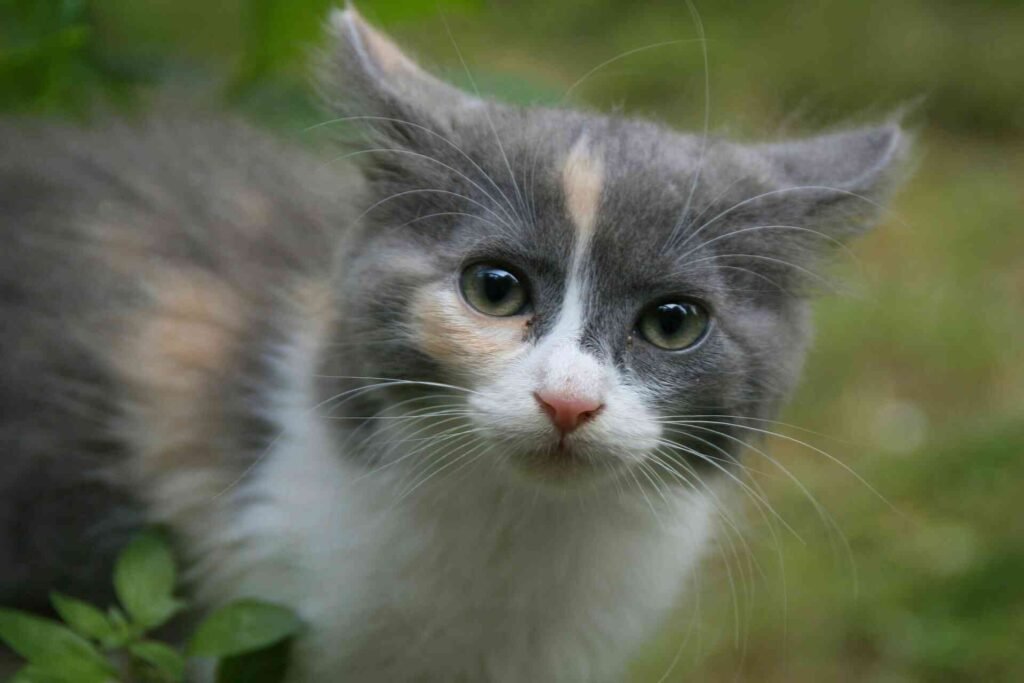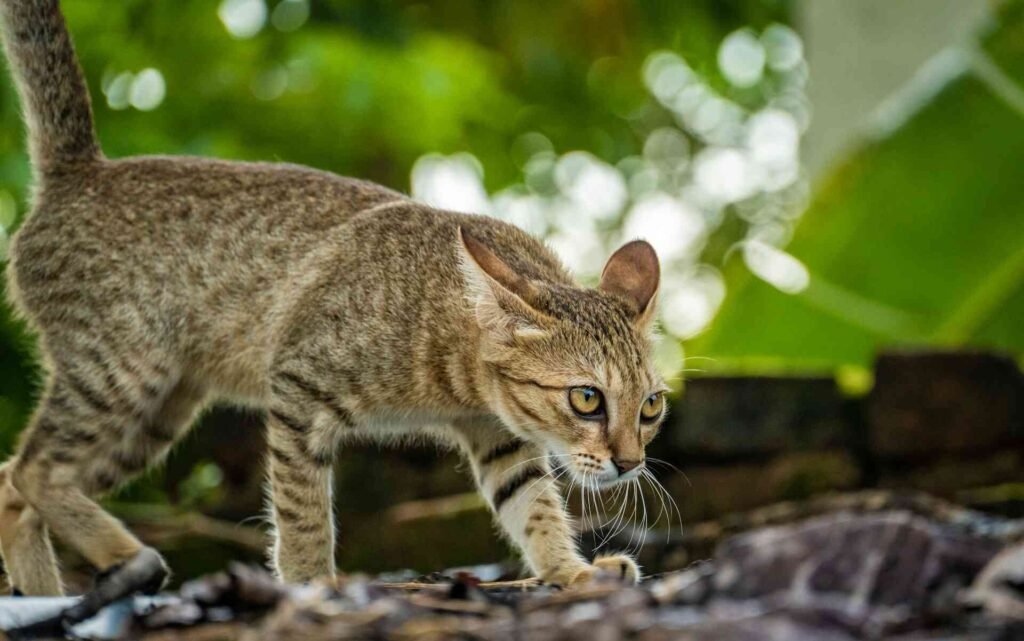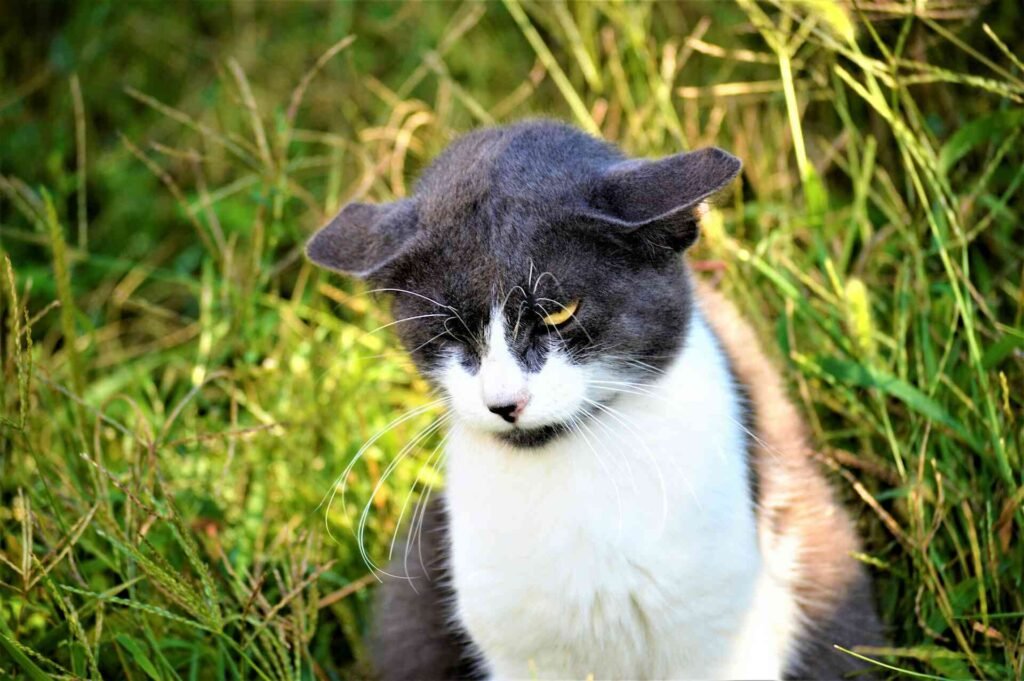Have you ever noticed your feline friend’s ears suddenly laying flat against their head? One moment they’re perky and alert, and the next, flat as pancakes. This distinctive change in your cat’s ear position isn’t random, it’s actually one of the most powerful ways our cats communicate with us and their environment.
Among all feline behaviors, ear positioning ranks as one of the most misunderstood yet crucial signals to recognize. When your cat’s ears go flat, they’re sending you an important message that deserves your attention.

The Language of Cat Ears: What Flat Ears Mean
A cat’s ears are remarkably expressive, serving as emotional barometers that reveal their inner feelings. When those normally upright ears flatten, it’s time to pay close attention. While many pet parents immediately assume aggression, cat flattened ears actually communicate a much wider range of emotions and intentions.
The Primary Reasons Behind Cat Ears Laying Flat
- Fear and Anxiety When your cat feels threatened or scared, flattening their ears against their head is a natural defensive position. This protects their sensitive ear canals from potential damage during conflict and signals submission to whatever is causing their distress. You might notice this when introducing your cat to new environments, during thunderstorms, or when unfamiliar visitors enter your home.
- Defensive Aggression When those ears go flat back against the head accompanied by a crouched position, dilated pupils, and perhaps hissing or growling, your cat is in defensive mode. They’re not trying to start trouble, they’re warning potential threats to back off. This often happens when they feel cornered or their territory is invaded.
- Offensive Aggression Sometimes flat ears indicate your cat is preparing to attack or defend territory. The difference from defensive positioning is subtle but important, offensively aggressive cats will often point their ears more to the sides rather than completely back, allowing them to maintain some directional hearing while preparing to engage.
- Discomfort or Pain Cats experiencing physical pain may flatten their ears as a reaction. If your typically friendly cat suddenly displays flat ears without environmental triggers, consider scheduling a veterinary checkup. Dental issues, ear infections, or other health conditions might be the culprit.
- Social Submission In multi-cat households, subordinate cats often flatten their ears when approached by more dominant felines. This non-verbal communication helps maintain social harmony by acknowledging the established hierarchy.
- Intense Focus Sometimes during hunting or play, cats flatten their ears sideways, not completely back, to help them focus on specific sounds or movements. This position helps them eliminate distractions and zero in on their target. You might notice this when they’re watching birds through the window or stalking their favorite toy.
Different Types of Flat Ear Positions
Not all flattened ear positions communicate the same message. Understanding these variations can help you better interpret what your furry friend is trying to tell you.

Cat Ears Flat Back
When your cat’s ears are pressed tightly against their head and angled backward, this typically indicates fear, extreme stress, or defensive aggression. This is the classic “airplane ears” position that many cat parents recognize as a warning sign.
Cat Ears Flat Sideways
Ears that are lowered and pointed outward horizontally often indicate mild irritation, uncertainty, or that your cat is processing something in their environment. This position isn’t as intense as ears flat back and may simply mean your cat is mildly annoyed or conflicted.
Partially Flattened Ears
Sometimes, only the tips of the ears fold slightly downward. This subtle position often suggests mild concern, attention shifting, or that your cat is feeling slightly uncomfortable but not truly threatened.
The Crucial Context: What Else Should You Look For?
A cat’s ear position never tells the whole story on its own. To accurately interpret what those flat ears mean, you need to consider their:
- Body posture: Is your cat crouched low or standing tall?
- Tail position: A puffed-up tail versus a low-hanging or twitching tail tells you very different things
- Vocalizations: Purring, hissing, growling, or silence?
- Pupil dilation: Wide, dilated pupils often accompany fear or aggression
- Environmental factors: Recent changes, new people, other animals, or loud noises
By considering these contextual clues alongside ear positioning, you’ll develop a much clearer understanding of your cat’s emotional state.
Common Scenarios: When Cat Ears Laying Flat Are Normal
| Scenario | Ear Position | Other Body Language | What It Means | How To Respond |
|---|---|---|---|---|
| Vet Visit | Completely flat against head | Tense body, may hide | Fear, anxiety | Speak softly, move slowly, consider calming pheromones |
| New Visitor | Partly flattened sideways | Alert posture, watching | Uncertainty, assessment | Give space, allow cat to approach on their terms |
| Conflict with Another Pet | Flat back, may alternate positions | Arched back, raised fur | Defensive aggression | Separate animals, never punish, reintroduce slowly |
| Playtime “Attack” | Slightly flattened, often moving | Playful pouncing, tail twitches | Focused hunting behavior | Encourage with appropriate toys, never use hands as toys |
| Petting Session Gone Wrong | Gradually flattening from normal | Tail twitching, skin rippling | Overstimulation warning | Stop petting immediately, give space |
When to Be Concerned About Your Cat’s Flat Ears
While flattened ears are often normal responses to temporary situations, persistent ear flattening without obvious triggers might warrant attention. Consider contacting your veterinarian if:
- Your cat’s ears remain flat for extended periods without environmental stressors
- The flattened ears are accompanied by head shaking, scratching, or discharge
- Your typically social cat becomes withdrawn and keeps their ears flat
- The behavior appeared suddenly with other changes in mood or appetite

These patterns could indicate underlying medical issues including ear infections, pain, or neurological problems that deserve professional evaluation.
How to Help a Cat With Flattened Ears
When your cat’s ears go flat, your response should vary depending on the underlying cause:
For Fear-Based Flattening
- Create a safe retreat space where your cat can hide
- Maintain a calm, quiet environment
- Use feline pheromone products
- Never force interaction when ears are flat
- Consider environmental enrichment to build confidence
For Aggression-Related Flattening
- Give your cat plenty of space
- Avoid direct eye contact which can be perceived as threatening
- Don’t punish, this escalates fear and aggression
- Identify and remove triggers when possible
- Consider consulting with a feline behaviorist for persistent issues
For Medically-Related Ear Flattening
- Schedule a veterinary examination
- Follow prescribed treatment plans consistently
- Monitor for improvements or changes
- Consider pain management options if recommended
The Development of Ear Communication in Cats
Cats begin communicating with their ears from kittenhood. While kittens are born with their ears folded, they quickly develop movement and control as they grow. By watching mother cats and siblings, young kittens learn to associate certain ear positions with specific outcomes and emotions.
Wild cats use the same ear positions as our domestic companions, this communication system developed through evolution as a vital survival mechanism. The ability to clearly signal fear, aggression, or submission without vocalizing helps cats avoid unnecessary conflicts and communicate efficiently within their social structures.
Frequently Asked Questions
Why do my cat’s ears go flat when I pet her?
If your cat’s ears flatten during petting, they’re likely experiencing overstimulation. Many cats enjoy physical affection but have sensitive thresholds, once crossed, they become uncomfortable and may flatten their ears as a warning before resorting to scratching or biting. Pay close attention to this early signal and immediately stop petting when you notice it. Some cats prefer brief, gentle interactions rather than prolonged petting sessions.
Can certain breeds have naturally flatter ears?
While breed variations exist in ear shape and size, from the curled ears of Scottish Folds to the large ears of Orientals, all healthy cats should hold their ears normally when relaxed. Temporary flattening is behavioral, not breed-specific. If a particular cat seems to have permanently flattened ears, this could indicate ear health issues requiring veterinary attention.
How can I tell if my cat is playing or actually aggressive when ears are flat?
Context provides the answer. During play, cats may momentarily flatten their ears while maintaining a relaxed body posture, making play-chirps, and engaging with toys enthusiastically. Their pupils may be dilated but not fixed in a hard stare. In contrast, aggressive flattening comes with tense muscles, thrashing tail, hissing, or growling. Play behavior should stop when the interaction ends, while true aggression often escalates or persists.
Is it normal for outdoor cats to flatten their ears more often?
Outdoor cats typically encounter more stimuli that might trigger defensive postures, including territorial disputes with other animals and exposure to unfamiliar sounds or situations. While they may indeed display flat ears more frequently, the behavior should still be situational and temporary. Consistent ear flattening, even in outdoor cats, warrants investigation.
Conclusion: Becoming Fluent in Feline
Learning to read your cat’s ear positions, particularly when they flatten their ears, is a fundamental skill for any cat parent. This silent communication system offers valuable insights into your cat’s emotional state, helping you respond appropriately to their needs and build a stronger bond based on mutual understanding.
By recognizing when your cat’s ears go flat and what specific variation they’re displaying, you can better respect their boundaries, address their concerns, and create an environment where they feel secure and understood. This awareness transforms ordinary interactions into meaningful conversations with your feline companion.
The next time you notice those distinctive flattened ears, take a moment to consider what your cat might be trying to tell you. Are they frightened? Overstimulated? In pain? Your thoughtful response to these signals won’t just improve your relationship, it will significantly enhance your cat’s overall wellbeing and quality of life.
Looking for more? Explore our Cat Health section for more posts like this, visit the Blog for fun and insightful reads, or browse our full Cat Category for everything feline-related, from care to comfort.
Disclaimer: This article is for informational purposes only and does not substitute for professional veterinary advice. Always consult your veterinarian for diagnosis and treatment tailored to your cat’s individual needs. Please verify current product information directly on the retailer’s site before purchasing.
Check out our most recent articles!
- Do Cats Sleep More in Fall? Seasonal Snooze Patterns ExplainedAutumn transforms even the most playful cats into professional nappers. But is your feline’s increased sleepiness just seasonal adjustment or something more? Here’s what’s really happening when the leaves start falling.
- Best Halloween Cat Trees: Gothic Furniture Your Cat Will Love Year-RoundWhy settle for boring beige cat furniture when you could give your feline a gothic throne? Halloween cat trees combine spooky aesthetics with year-round functionality, offering everything from coffin-shaped beds to spider-web platforms.
- Can Cats Sense Weather Changes? Decoding Your Cat’s Inner MeteorologistCats aren’t psychic, but their sensory superpowers make them excellent storm detectors. From hearing distant thunder to feeling pressure changes in their ears, discover what your cat knows about tomorrow’s weather that you don’t, and how to help them cope with weather anxiety.
- How Long Does It Take for Cat Whiskers to Grow Back?Ever found a mysterious whisker on your carpet and wondered if it’ll grow back? The good news is that cat whiskers do regrow, typically within 6-12 weeks, though several factors can influence this timeline.
- How to Get a Scared Cat Into a Carrier: Stress-Free Solutions That Actually WorkForcing a scared cat into a carrier backfires every time. Smart cat parents use patience and positive associations to transform that dreaded plastic box into a welcome retreat.
- Why Does My Cat Act Scared of Me Sometimes? Cat Fear and Building TrustWhen your beloved cat suddenly seems frightened of you, it can feel heartbreaking. But feline fear has identifiable causes and proven solutions that can restore your special bond.
- Do Dental Treats for Cats Actually Work? Feline Oral Health ExplainedWhile dental treats can’t work miracles, they’re surprisingly effective tools for maintaining feline oral health when used correctly. Discover which products actually deliver results and how to maximize their benefits for your cat’s teeth and breath.
- Where Do Feral Cats Sleep? Outdoor Cat Resting SpotsEver wondered where neighborhood cats disappear at dusk? Discover the fascinating world of feral cat sleeping habits and the survival instincts that guide their nightly shelter choices.
- Why Does a Mother Cat Bite Her Kitten’s Neck? Feline Maternal BehaviorNature’s Perfect Transport System: Ever wondered why mother cats carry kittens by the neck? This ancient behavior triggers a special relaxation response that keeps babies safe during moves, and it’s far more sophisticated than it looks.
- Are Stainless Steel Bowls Good for Cats? Upgrading Your Cat’s Feeding ExperienceWhile plastic bowls develop bacteria-harboring scratches and ceramic can chip dangerously, stainless steel maintains its smooth, hygienic surface for years. Learn why this simple switch could transform your cat’s mealtime.










